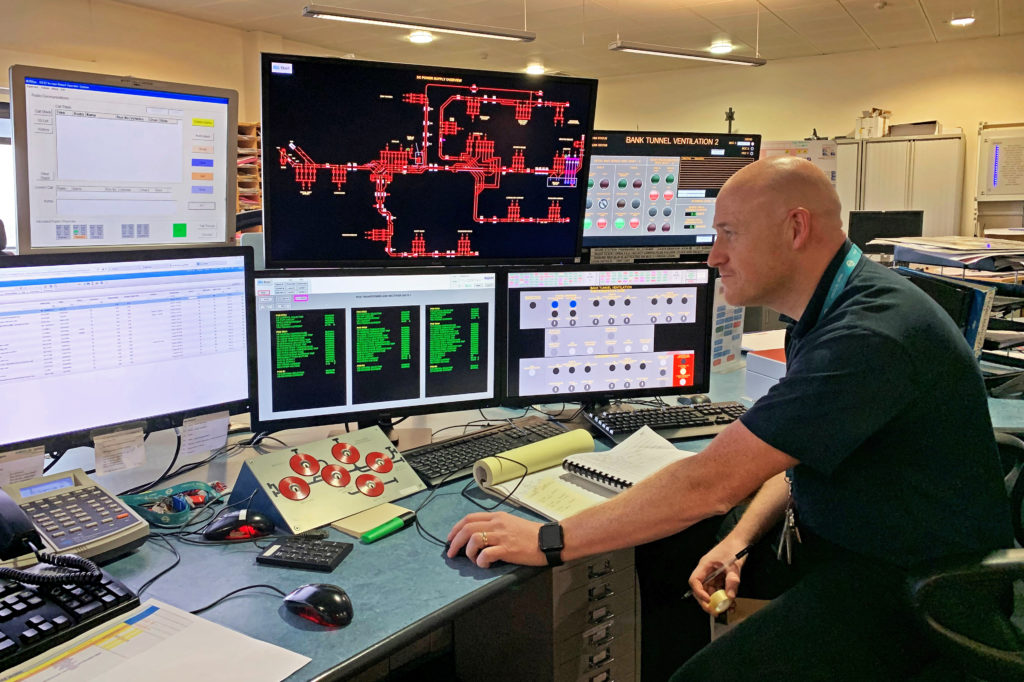The Docklands Light Railway (DLR) has been a feature of the east side of London for many years now; it’s difficult to remember a time before it. However, the system has expanded considerably since the early days and has evolved to becoming a core part of the Transport for London (TfL) network. As well as stretching its boundaries, the system was integral to the delivery of London’s Olympics in 2012.
The DLR opened in 1987 with 11 twin-car articulated units and 15 passenger stations; the scope is now 45 stations with a significant fleet of two and three-car trains.
The visual impact of those changes has been significant, both in the rolling stock and hardware infrastructure seen by customers, neighbours and stakeholders. This is an electric railway and behind the extra rails that supply the trains is a complex and sophisticated network, taking power from the distribution network operator, transforming and rectifying it to Direct Current at the rail.
Looking back
This complex and vital part of the rail system requires control over power delivery and, from the earliest days of electric rail traction, this has been supervised. A visit to the Science Museum reminds one that this supervision was originally undertaken by an individual at the supply point who, in the very earliest installations, would open and close circuit breakers and switches by hand, sometimes with a long (insulated!) pole.
As time passed and the delivery became more complex, the system of supply became a network operation and significant advantage was seen in supervising – and controlling – the distribution system from a single point. The process became a remote operation with many distinct remote units being worked and supervised from a central point. Thus was born a comprehensive philosophy of supervision which also allowed the status of the operated points to be observed. From this came the acronym SCADA – Supervisory Control and Data Acquisition.
Over the years, the requirements of systems have become more complex and the demand for feedback on the control and operation of electrical supplies has evolved. From an early and essentially electro-mechanical system has emerged the modern computer-based systems and even the early versions of that philosophy have been overtaken with advances in control systems.
Thus, the SCADA system installed for the Docklands Light Railway has evolved as the railway has advanced and, by 2015, a view emerged that the installation required replacement to allow improved operation and flexibility.
Room to expand
A brief view of the organisation structure within which the DLR operates shows that the railway is managed by Transport for London through its sub-organisation Rail for London, under which is Docklands Light Rail Ltd, owner of the infrastructure and rolling stock. The day-to-day operation of the infrastructure lies in the hands of KeolisAmey Docklands, the contractor responsible for maintenance. Capital renewal items are normally the task of the infrastructure owner, whilst the rolling stock is provided by TfL.

The initial traction power supervision was a GEC system, initially controlled via a mimic panel at Poplar Control Centre. After some time, the equipment was replaced by a system of Transmitton manufacture, based on Poplar Control Centre – Transmitton being a well-known company with a long history of SCADA systems in rail.
This installation had been replaced by a Siemens Cromos arrangement, installed at the time of the addition of the London Olympics. The control room and human/machine interface is still based at Poplar. Further upgrades included the commissioning of a new control room at Beckton which became the master location for the supervisory function. Poplar remained as a secondary location.

Expansion of the railway is being planned for, requiring further flexibility which the new system can deliver. A new extension is being mooted to Thamesmead. By 2018/19, the decision was made to replace the existing system and, to that end – after tendering – Sella Controls Limited was awarded the contract to undertake the works.
The power distribution system would retain the same hardware, the SCADA renewal being focused on the supervisory performance; physical renewals of distribution gear and other remote units emerged as a future separate set of renewals. In terms of electrical distribution layout, the Docklands Light Railway owns the 11kV high-voltage network with around 80 remote terminal units in a ring-main formation. Allowance may be easily made to cover replacements; for instance, ring-main units will be replaced allowing the adoption of remote control of that part of the system.
At the point of decision to undertake major renewal of the supervisory system, an important aspect of the review looked at allowing for future extension and the increased flexibility from a more modern advanced system. A significant influence was the ability for the Poplar and Beckton locations to work, in effect, as one, the Poplar site acting in backup in hot standby conditions. The new arrangements would allow more flexible maintenance tasks using the Poplar location. In addition, extra control functionality was to be taken into account.
Previously, tunnel ventilation had been supervised as well as power supplies, but the system would now be required to overview other plant systems. A further gain has been the ability to take isolations and make safe the conductor rail system securely and remotely, resulting in greatly enhanced safety for trackworkers. The system was also arranged to offer an emergency switch-off protocol.

Keep it familiar
Following appropriate commercial activity, Sella Controls was selected to deliver the replacement supervisory system and, to meet modern and effective protocols, was given ‘early contractor involvement’ conditions, allowing best practice in client/supplier communication. Although Transport for London is the infrastructure owner, KeolisAmey Docklands was allocated the delivery management responsibility and thus an effective partnership was sealed.
The works were undertaken to comply with Transport for London’s delivery processes. The new system was to be capable of instantaneous switchover, yet have the same desktop appearance for control room technicians to recognise, enabling the same architecture and protocols.
Sella Controls was seen to have a solid history and track record, having undertaken the significant task of replacing a Cromos system on the Piccadilly Line. They were thus able to bring that experience to the task in Docklands.
From contract award in 2019, installation was undertaken in an effective and supportive relationship with the client, culminating in final commissioning of the revised system in 2020. The work progressed under the severe challenge of the Covid pandemic which had, of course, been in nobody’s mind during tendering.
Not all commissioning could be undertaken remotely and local physical attendance on site was carefully and vigorously managed to the client’s satisfaction. Acceptance tests were carried out in the light of the new social-distancing requirements and Sella Controls was able to adapt behaviours to that environment. Similarly, KeolisAmey Docklands was also able to adjust to the revised acceptance and approval processes.

The installation also brought new opportunities for operations processes, allowing more robust system management and analysis. The original SCADA system received information in the form of active picture displays (mimics), alarm and event messages, and printed reports; this functionality was successfully retained and achieved the aim that control room technicians would view a familiar interface.
Following successful commissioning and completion, Sella Controls has been able to deliver a robust and enhanced supervisory and control system for this important London railway network, as well as laying the foundations for better operations analysis and effective control, not only of the traction power system but also the other items of plant now under the control of the management centre at Beckton.
In detail
It is worth noting the technical specifications of the Sella Controls product. Substation control and automation are enabled via a Tracklink® remote terminal unit or the integration to third-party equipment, control being provided using traditional hardwired I/O or modern substation automation protocols.
The company’s extensive software tools allow interfacing to intelligent switches to monitor network performance. A user will discover key features such as the future-proof design and the advantage of interchangeable modules which can significantly reduce downtime. To aid integration and fitting, the equipment sports flexible compact enclosure design and, overall, helpfully effective maintenance and spares requirements.
The important remote securing capability is provided by integrating Tracklink® or third-party controllers which are installed into specialist negative short-circuit devices enabling electrical sections to be remotely isolated. Once in place, ownership of the isolation is transferred to the Nominated Person and returned on release.
In addition, Tracklink® SCADA can provide full electrical modelling and network management capability. Whilst in ‘Live’ mode, the primary function of the traction power supervisory system is to derive the state of power sections and sub-sections which allows operators to monitor the state of the network using isolation mimics. In the ‘Planning’ mode, the user can test the effect of an isolation, sequences of isolations or individual switching operations – a valuable facility in a developing network.

With thanks to Sella Controls, under the lead of Chris Elliott and Jay Sampat, and KeolisAmey Docklands senior staff Raj Parmar and Steve Bailey, together with Clare Donovan from Public Affairs.


